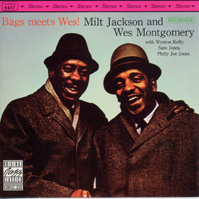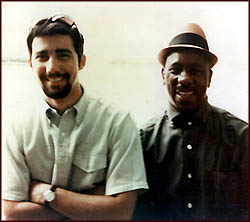

|
Soundclip:
|
| See
Steve's Hand-Written Transcription |
|
Wes Montgomery's solo on: "Sam Sack"(Milt Jackson) One of the great thrills over the course of my career is that, in some small way, my name has been linked to that of Wes Montgomery. I can't describe what a tremendous honor it was to have been asked by Orrin Keepnews to write the liner notes for Wes Montgomery's double-LP release "GROOVE BROTHERS"(Milestone) and then, years later, to be again asked to contribute a personal recollection to the box set, "WES MONTGOMERY-The Complete Riverside Recordings."  However, many guitarists
associate me with Wes because of my book of transcriptions,
"The WES MONTGOMERY Guitar Folio"(Gopam
Music). The following is an analysis of one-half of
Wes' four-chorus solo on Milt Jackson's blues in 'F',
"Sam Sack" which was recorded on the 1961 CD, "BAGS MEETS
WES"(Riverside). When I was assembling the transcriptions
for the book, I tried to focus more on Wes' fantastic
single-line improvisations than the octaves which served
to make him famous. This transcription focuses solely
on the first two choruses he played prior to launching
into two more choruses of octaves.
However, many guitarists
associate me with Wes because of my book of transcriptions,
"The WES MONTGOMERY Guitar Folio"(Gopam
Music). The following is an analysis of one-half of
Wes' four-chorus solo on Milt Jackson's blues in 'F',
"Sam Sack" which was recorded on the 1961 CD, "BAGS MEETS
WES"(Riverside). When I was assembling the transcriptions
for the book, I tried to focus more on Wes' fantastic
single-line improvisations than the octaves which served
to make him famous. This transcription focuses solely
on the first two choruses he played prior to launching
into two more choruses of octaves. Wes' first chorus begins as Milt Jackson's solo ends, so there's a brief pause and Wes actually enters with a pick-up to bar 3. This particular chorus is relatively simple and fundamentally filled with very fundamental blues language, along with one motivic passage from bars 7-9. However, it's in chorus 2 that Wes displays his wonderful command of the bebop language and some sophisticated harmonic devices often associated with John Coltrane. It's interesting that in Wes' pick-up to this chorus, he outlines a C minor triad and then offers a descending line which could be interpreted as being in F Mixolydian or C Dorian. Bar 4 has always been a source of interest and study for jazz students for itĚs the bar where the I7 chord 'really' becomes a dominant 7th chord with alterations to pull it towards the IV7 chord. In this key, we would have F7(alt.) going to Bb7. Aside from the obvious possibility of using the F altered dominant scale(F, Gb, Ab, A, B, C#, Eb), many players of the Coltrane era(and well beyond) have sought to take the b5 substitute(here this would be B7) and placing a iim7 chord in front of it(here an F#m7). If one was going to employ this device, you should see notes which might indicate either B Mixolydian or F# Dorian(F#, G#, A, B, C#, D#, E). If you look and compare closely, it's very 'close' to the F altered dominant scale except for the difference of E-natural and Eb). If you analyze bar 4, it's obvious that with his line, Wes was employing this device, making it a keen point of interest.  Another always interesting
moment in any blues chorus is what a player might do
with bar 8. Often times, the treatment will depend upon
how bar 9 is approached during the melody or by the
agreed upon 'solo changes.' In this case, the changes
are headed to Gm7 in bar 9. Obviously the V7 chord to
Gm7 would be a D7(alt.) but in this case, Wes employs
another great linear device by using a line which approaches
the Gm7 from a 1/2-step above. Examine the notes he
plays in bar 8 and you can see that they outline Abm7(9)
or Ab Dorian.
Another always interesting
moment in any blues chorus is what a player might do
with bar 8. Often times, the treatment will depend upon
how bar 9 is approached during the melody or by the
agreed upon 'solo changes.' In this case, the changes
are headed to Gm7 in bar 9. Obviously the V7 chord to
Gm7 would be a D7(alt.) but in this case, Wes employs
another great linear device by using a line which approaches
the Gm7 from a 1/2-step above. Examine the notes he
plays in bar 8 and you can see that they outline Abm7(9)
or Ab Dorian. As this chorus winds down he does one more interesting thing in bar 10 by playing a bluesy 'turn' which highlights three tones from the C altered dominant scale(C, Db, Eb, E, Gb, G#, Bb). Those tones are Eb, E(Fb), and Db and help drive the line home to resolution on F. The expected device might be to simply play F blues-based lines over those bars. Again, this excerpt from a solo serves to showcase that Wes was a very sophisticated improviser for someone who had no real formal theory training as a player. In the end, he possessed the greatest gift of all, great ears!
[Photo: Steve with Wes Montgomery at the Hollywood Bowl Concert,
ca. 1966.
Original Polaroid: Sammy Cahn] |